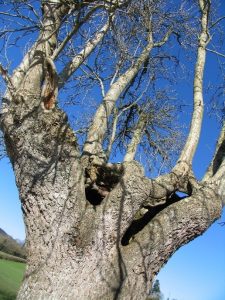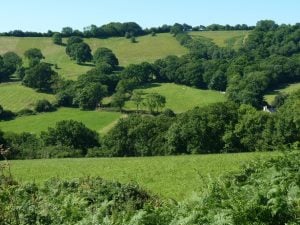Ash is a common tree across most of Devon. It is often abundant within hedges and other linear landscape features such as strips of trees alongside rivers, roads and railways. It is also a frequent tree within our woodlands.
For more information about ash trees, including how to identify ash, please visit the Woodland Trust website and read The Ash Tree by Oliver Rackham.
Distribution in Devon
Ash is a common species within most of our woodlands, often along with oak. It frequently dominates as small woodlands of 0.5 ha or less both in semi-natural woods and plantations.
As a hedgerow tree, ash is our second most frequent tree after oak and as a component of the shrub layer of hedges, the fourth most frequent species after blackthorn, hazel and hawthorn. They line many of the County’s highways. In urban and other built-up settings, ash trees are frequent, within parks and gardens and alongside roads.
See key facts on the distribution of ash trees in Devon.
Importance of ancient and veteran trees

In wildlife, landscape and historic terms, ash trees that are veteran and ancient are the most valuable trees. Ancient and veteran ash trees are mainly found within the county’s parklands and hedges, rather than within closed woodlands. In 2016, the Ancient Tree Inventory listed 12 ancient ashes within Devon and 123 other veterans. These include five trees with a girth greater than 6m, nine with a girth greater than 5m, 36 greater than 4.71m (the threshold for potential national significance according to the Joint Nature Conservation Committee), and 96 greater than 3m. The largest girth is 6.32m, which is massive. Many more large trees exist but are as yet unrecorded.
Wildlife importance
Ash trees are a key component of our ecosystem. Across the UK, nearly a thousand species are known to be associated with ash trees: including birds, mammals, bryophytes, fungi, invertebrates and lichens. Of these many are highly associated with the tree, and some are restricted to it. Those species which are in the last category, and those that are strongly associated with ash and even without ash dieback are threatened nationally, are those at particular risk. There are 69 such species in the UK: Of these, 17 at least occur in Devon.
Assuming high levels of ash tree mortality, of all the different species associated with ash, one or two lichens are at risk of extinction at a county level, while other obligate and highly associated species found in the county will experience large population declines.
See a list of species that are entirely or mainly dependent on ash known to occur in Devon.
For more information about ash and associated species see Mitchell, R.J. et al. 2014 and for an assessment of the impacts of ash dieback on woodlands and trees of conservation importance Natural England report NECR 151 (2014).
Landscape importance

Copyright David Colman
A distinctive pattern of trees, woodland and hedgerows characterise the majority of Devon’s landscapes. Hedgerow trees are listed as being important landscape features in the profiles of all six of Devon’s National Character Areas, with ash often specified along with oak and beech. The importance of conserving ancient and veteran trees is usually highlighted.
Economic importance
The economic importance of ash trees goes way beyond simply the value of their timber. Like other trees, ash trees are an important part of our ‘natural capital’. They provide many other benefits to society that are now becoming more widely recognised and valued in economic terms. This includes removing pollutants from the atmosphere, helping to reduce flooding and surface water runoff, and providing less tangible benefits our health and wellbeing. See the Forum’s Advice Note: The many benefits of ash trees.
Cultural significance
Ash is important to Devon’s people and to its environment in many ways. The tree enriches our lives, is valued for its timber and as firewood, and is important culturally.
Ash is important in Celtic mythology and hence to our culture. For example, nine parishes in Devon have ash in their names (Ashburton, Ashbury, Ashcombe, Ashford, Ashprington, Ashreigney, Ashton, Ashwater, Rose Ash), more than for any other tree. Mature specimens are frequently used as markers when beating the bounds.
For further information about the importance of ash, including its value to the local economy, see the Forum’s Advice Note: The many benefits of ash trees .